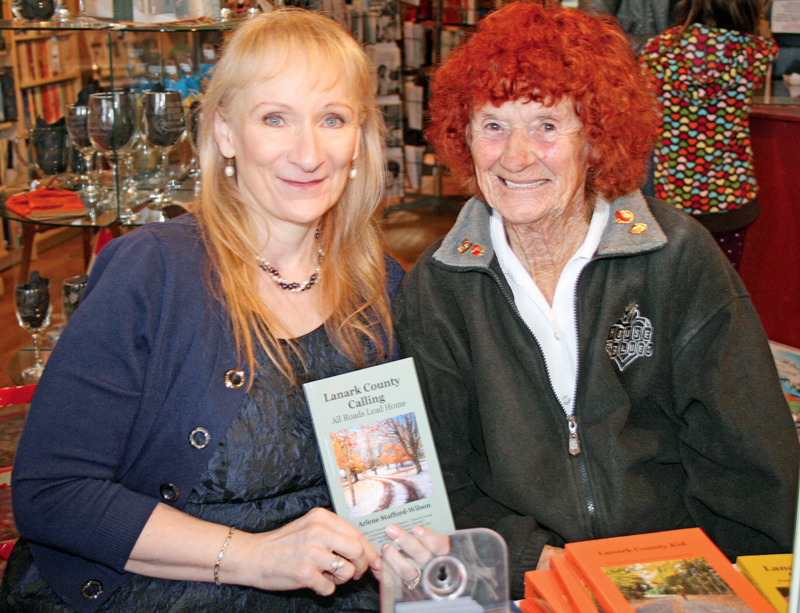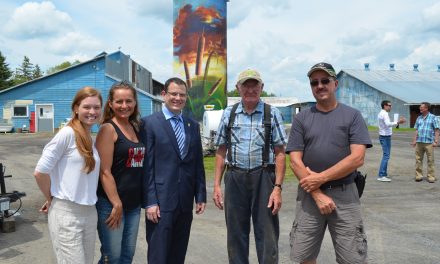Violet Gariepy (right) who worked at the Soper Theatre in Smiths Falls for more than 50 years was among those in attendance for the book launch at The Book Nook in Perth on Sept. 29 for author Arlene Stafford-Wilson’s (left) newest book, Lanark County Calling: All Roads Lead Home. The theatre is among the collection of stories featured in the book. Pinder-Moss photo
A compilation of stories about some memorable Lanark County local people and places of 1960s and 1970s
by Dianne Pinder-Moss
AgriNews Contributor
LANARK COUNTY – While it’s been many years since Arlene Stafford-Wilson lived in Lanark County, she will always consider herself “a country kid.”
“I miss falling asleep in the summer hearing the crickets outside, or watching the bats and fireflies on warm summer evenings after a long hot day,” the now resident of Ottawa says as she reminisces about her childhood growing up on the Third Line of Bathurst Township (currently part of the amalgamated Tay Valley Township). “I miss hearing the sounds of the trains rumbling down the tracks back near the 4th line. I also miss walking into the little church Sunday mornings and seeing everyone I know, and of course the candlelight services on Christmas Eve. I think about those things a lot. I cherish those memories of those days.”
With many of those familiar faces from that small country church, Calvin United, now gone, Stafford-Wilson strives to keep the memories of that time period alive through her writing.
“I want to make sure people remember what it was like to grow up in that time period – the 1960s and ‘70s,” she states.
Her newest book, Lanark County Calling: All Roads Lead Home, is a compilation of stories about some memorable people and places of that era. These include the Ompah Stomp, The Soper Theatre in Smiths Falls, Sophia Haggis — the “Candy Lady” of Perth, the Ghost of Ferguson Falls and the Witch of Plum Hollow.
In deciding on what stories to include in the book, Stafford-Wilson told the AgriNews it has always been important to her “to capture people and places so that they will be remembered in future generations.” As an example, she noted that Haggis was such “a trailblazer” not for her candy making as much as she was for being one of the first women bus drivers in Kingston – “a job she did to support her child as a single parent.”
Similarly, the author pointed out that Jane Elizabeth Barnes, who also became known as the Witch of Plum Hollow, started reading tea leaves to support nine children on her own after her husband left and moved to Smiths Falls. She wanted readers to know that this woman, who ended up helping police solve crimes, was a single parent who came up with something innovative to provide for her family.
Another “very interesting fellow,” who Stafford-Wilson shares about in her most recent literary work, was Bert Soper, the owner of the first movie theatre in Smiths Falls who had been a Liberal MP for the Lanark riding from 1940-45.
“Probably most people, if asked, couldn’t even tell you who the Soper Theatre was named for and I wanted people to remember Bert – the man, the horse lover, the horse-racing enthusiast,” she stated. “Like the other main characters in many of my stories, he took lemons and turned them into lemonade so to speak. They rose like the Phoenix out of the ashes, out of difficult situations and became successful.”
It was during the author’s childhood that she initially heard the story of the ghost of Ferguson Falls from her late father.
“Dad loved a good story — must have been the Irish blood in him,” she stated fondly.
Another great story teller that Stafford-Wilson says she encountered from there was the late Jim Quinn.
“He spoke with me about all of the old families who settled around Ferguson Falls, going back to the Seven Irish Bachelors,” she mentioned. “He had it all in his head, nothing written down, and I do believe that this was in part because of the story-telling that went on in the evenings before they all had televisions. It was a way to pass the time for that generation.”
Referring to a quote from one of her favourite authors, Mark Twain, who stated, “Write what you know”, Stafford-Wilson believes that everyone has their own stories to tell and that only they can tell them.
“Our own stories document a first-person account from a point of view unique to us,” she remarked.
In her new book, Stafford-Wilson has a personal connection to most of the stories.
The first motion picture she ever saw at a theatre was at the Soper at a young age when her brother Tim took her to a James Bond movie.
Likewise, she spent some time during her high school years “hanging out” with Haggis at her candy store on Gore Street. The store where the candy maker created her popular Horehound candy and other sweet treats like taffy, fudge and the author’s personal favourite, milk chocolate peanut clusters, is the current location of The Book Nook where the book launch was held on Sept. 29.
Similarly, Stafford-Wilson was an attendee at the Ompah Stomp.
“I’m not sure exactly how many times I attended the Ompah Stomp, but I do recall the wonderful talented performers, the lively crowds, the kind people who volunteered at the event and the beautiful tranquil setting,” she related. “Those are the things that I treasured about the event.”
Little did Stafford-Wilson imagine when she released her first book, Recipes and Recollections — Treats and Tales From Our Mother’s Kitchen, in 2011 that it would be followed by six more. Interestingly, that book was originally intended to take the form of a small folder of her late mother Audry Stafford’s recipes to be given as a Christmas gift to the grandchildren.
At the time, she thought she might have 10 or 12 recipes to share. However, once she reached out to her two brothers and two sisters for some of their mother’s recipes, she ended up with 93 recipes in total. In addition, each included memories associated with the recipes, whether it be one of mom’s award winning pies for the Perth Fair, the cookies one brother remembered being sent with them when they worked on the milk truck for Chaplin’s Dairy, etc.
“Each of my siblings begin reminiscing about the recipes that they sent, so I started writing their stories and the memories that they shared and ended up with a 300-page book,” she recounted.
At that stage, in honour of their mother, Stafford-Wilson’s siblings suggested getting the book printed and donating copies to Calvin United Church, which they attended as children. The book ended up being used as a fundraiser by the church.
After that, the rest is history. When asked whether she considers herself a story teller or local historian, Stafford-Wilson replied by saying both. While she loves telling stories, particularly ones that have been passed down from others, she also has a keen interest in preserving the history of the 1960s and ‘70s — the days of her youth.
“We began in such innocent circumstances at the little one-room school, and while we were children, we recall having to get under our desks because there was a threat of nuclear war – during the Cold War years,” she related. “We watched as the war in Vietnam unfolded each night on the evening news. We witnessed the first man walking on the moon. We lived through the hippies, the flower-power years, observed the struggles of the civil rights movement in the U.S., and our teenage years as we enjoyed arguably the best rock and roll ever played.”
Through her books, Stafford-Wilson hopes to record and preserve what it was like growing up “in those very magical times.”
“I believe it’s a time that historians will look back on, and I feel as though I am helping to document what it was like being there and being a part of it as it unfolded,” she said.
The author makes it clear however that the research for Lanark County Calling and its predecessors was greatly aided by the support of the community. For instance, in regards to the current book, she said Neville Wells and Marilyn Dunham were “very kind” to share their stories and memories about the Ompah Stomp.
“I wanted to make sure that the story of the Ompah Stomp was told accurately, because there had been so many rumours about what went on there, and why it eventually closed in 2000,” she stated. “It was important that the story be documented. It was another magical place that was unique to our time!”
Likewise, she related how former employees of the Soper Theatre were keen to share their stories.
“Ushers I spoke with loved telling their stories about policing the back rows where the smoking, drinking, and amorous behaviour sometimes got out of hand,” she mentioned.
In fact, long-time employee Violet Gariepy who worked at the theatre from 1958 until it closed in 2012 – initially working at the candy counter and, in later years, being a familiar face at the front ticket booth – attended the book launch at The Book Nook.
“I think what she did is awesome,” Gariepy said of Stafford-Wilson’s account of the theatre included in the book. In fact, when the author read aloud a couple passages from this particular story, both got teary-eyed.
Afterwards, in an email response, Stafford-Wilson spoke of how researching and writing a story over so many months makes it difficult not to become somewhat attached to the people in the stories “and to empathize with their struggles, as well as their victories.”
“Almost everyone I spoke with who were former staff at the Soper said that working there was like being a member of a family,” she stated. “The employees took it very hard when they were told that it would be closing, and for Violet, it was like a second home.”
Violet’s daughter, Karen Gariepy, believes the story of the Soper is an important one to tell “for the history.”
Otherwise, “all of the new people moving there (to Smiths Falls) wouldn’t even know there was a theatre,” she commented.
While Stafford-Wilson is pleased with the popularity of her books, she believes there is a niche for this type of writing because of the lack of books with local stories.
“I would like to picture my readers smiling when they read a passage about a place they know,” she stated. “One of my readers from Almonte sent me a note saying that he knew exactly the road that I wrote about as he had driven on that road many times and that the story brought back memories of his childhood. That always makes me smile when I hear that, and I feel like, well…mission-accomplished!”
With any of her books, Stafford-Wilson’s hope is that readers will recognize a name or two –whether it be their neighbour, their cousin or even a close family member – and realize that their memory has been captured forever in the book.
“I want to honour the ordinary person – the owner of a general store, the ladies at the church who baked for the auction sale, the kids who hung around the corner at DeWitt’s when our lives stretched out ahead of us like a freshly-paved highway, not knowing what the future would hold for any of us,” she stated. “I like to capture the extraordinary things that happen to ordinary people – as in the story of Sophia Haggis, or Bert Soper, a farm-kid from Leeds who would become the Member of Parliament for Lanark, a successful business man, and owner of the local theatre. That’s a story worth remembering.”
Stafford-Wilson concedes that she wandered out of Lanark County for two of the stories in her new book. Thus the choice of the words, “All Roads Lead Home”, in the title.
“With that title, I wanted to convey to the reader that whether we drift a bit outside of the county, or move across province, or on the other side of the world, Lanark County is the kind of place that always brings you back home, pulls a person in like a magnet,” she explained. “Maybe it’s the landscape, the people, a little of both, but I’ve always found myself drawn back there again and again.
Along with The Book Nook, Lanark County Calling is also available for sale in Perth at the Bookworm. As of press time, copies could be purchased as well at Mill Street Books in Almonte.
Those who love reading Stafford-Wilson’s books will be happy to know that when she was queried about the prospect of writing an eighth book, her response was “probably.”
“Well, I’ve always got a story or two knocking around in my head, and sometimes I will be inspired by something I hear or see,” she remarked. “I don’t have anything on paper at the moment, just having finished Lanark County Calling, but I’m sure it won’t be the last.”













